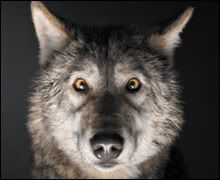Post by muskyhusky on Oct 26, 2008 13:59:57 GMT -6
MADISON – There were an estimated 540 to 577 gray wolves across Wisconsin over the winter of 2006-07, according to the finalized wolf count compiled by biologist with the Wisconsin Department of Natural Resources. This is down slightly from the preliminary estimate of 540 to 600 wolves biologists made in April, but still as much as 16 percent higher than the winter 2005-06 estimate of 467 to 504 wolves.
“This number represents the estimated number of yearling and adult wolves in the population prior to the birth of pups this spring,” says Adrian Wydeven, mammalian ecologist for the Department of Natural Resources. “The population probably doubles after pups are born before leveling back down in fall and winter.”
The winter count of wolves is used to gauge the status of the wolf population and set management goals. It is compiled using aerial tracking of radio collared wolves, snow track surveys by DNR and volunteer trackers, and collections of public reports on wolf observations. The DNR has conducted these counts of wolves every year since winter 1979-1980 when there were 25 wolves in the state.
In 2007, at least 12 wolves were found on Indian reservations, and total count outside of Indian reservations was at least 528 wolves. The state management goal set in the 1999 Wisconsin Wolf Management Plan was 350 wolves outside Indian reservations, putting the current population at 178 wolves above the management goal.
A total of 138 wolf packs – consisting of at least two adult wolves each -- were detected in Wisconsin. Twenty packs were distributed across central Wisconsin and 118 packs existed in northern Wisconsin. The largest pack in the state was the Hoffman Lake pack near Park Falls consisting of nine wolves. At least 45 packs had five or more wolves in them.
On March 12, 2007, wolves in Wisconsin and other portions of the western Great Lakes were removed from the list of federally endangered and threatened species. Management authority was returned to the states, allowing more flexible systems for dealing with problem wolves.
Since that time problems wolves have killed livestock on nine farms in Barron, Bayfield, Douglas, Dunn, Price, Rusk, Sawyer, and Shawano counties. Trapping by U.S. Department of Agriculture Wildlife Services was conducted on eight farms, and 10 wolves were captured and euthanized at four of the farms. The DNR also issued shooting permits to eight landowners with recent wolf problems, but no wolves have yet been shot by landowners.
One landowner near Park Falls in Price County did shoot a wolf in the act of attacking a border collie. The shooting of wolves in the act of attacking pets or livestock by the landowners or renters of land is allowed on their property, but the law requires the local conservation warden be contacted within 24 hours.
Two wolves were also captured and radio collared by USDA-Wildlife Services and DNR near sites where wolves were causing concerns, to allow more careful monitoring of those wolves. Additionally nine other wolves were live-trapped and collared on public land by DNR and USDA-Wildlife Services to monitor the state population.
FOR MORE INFORMATION CONTACT: Adrian Wydeven - (715) 762-1363
“This number represents the estimated number of yearling and adult wolves in the population prior to the birth of pups this spring,” says Adrian Wydeven, mammalian ecologist for the Department of Natural Resources. “The population probably doubles after pups are born before leveling back down in fall and winter.”
The winter count of wolves is used to gauge the status of the wolf population and set management goals. It is compiled using aerial tracking of radio collared wolves, snow track surveys by DNR and volunteer trackers, and collections of public reports on wolf observations. The DNR has conducted these counts of wolves every year since winter 1979-1980 when there were 25 wolves in the state.
In 2007, at least 12 wolves were found on Indian reservations, and total count outside of Indian reservations was at least 528 wolves. The state management goal set in the 1999 Wisconsin Wolf Management Plan was 350 wolves outside Indian reservations, putting the current population at 178 wolves above the management goal.
A total of 138 wolf packs – consisting of at least two adult wolves each -- were detected in Wisconsin. Twenty packs were distributed across central Wisconsin and 118 packs existed in northern Wisconsin. The largest pack in the state was the Hoffman Lake pack near Park Falls consisting of nine wolves. At least 45 packs had five or more wolves in them.
On March 12, 2007, wolves in Wisconsin and other portions of the western Great Lakes were removed from the list of federally endangered and threatened species. Management authority was returned to the states, allowing more flexible systems for dealing with problem wolves.
Since that time problems wolves have killed livestock on nine farms in Barron, Bayfield, Douglas, Dunn, Price, Rusk, Sawyer, and Shawano counties. Trapping by U.S. Department of Agriculture Wildlife Services was conducted on eight farms, and 10 wolves were captured and euthanized at four of the farms. The DNR also issued shooting permits to eight landowners with recent wolf problems, but no wolves have yet been shot by landowners.
One landowner near Park Falls in Price County did shoot a wolf in the act of attacking a border collie. The shooting of wolves in the act of attacking pets or livestock by the landowners or renters of land is allowed on their property, but the law requires the local conservation warden be contacted within 24 hours.
Two wolves were also captured and radio collared by USDA-Wildlife Services and DNR near sites where wolves were causing concerns, to allow more careful monitoring of those wolves. Additionally nine other wolves were live-trapped and collared on public land by DNR and USDA-Wildlife Services to monitor the state population.
FOR MORE INFORMATION CONTACT: Adrian Wydeven - (715) 762-1363


